Product Introduction
Model CS350M EIS potentiostat /galvanostat / electrochemical workstation consists of DDS arbitrary function generator, high power potentiostat/galvanostat, dual-channel correlation analyzer, dual-channel high-speed 16bit/high-precision 24bit AD converter and extension interfaces. Max. current is ±2A, potential range is ±10V. EIS frequency range is 10uHz~1MHz. It can be used for various electrochemical fields such as corrosion, energy, material and electroanalysis. The current can be boosted up to 20A/40A with a current booster CS2020B/ CS2040B.
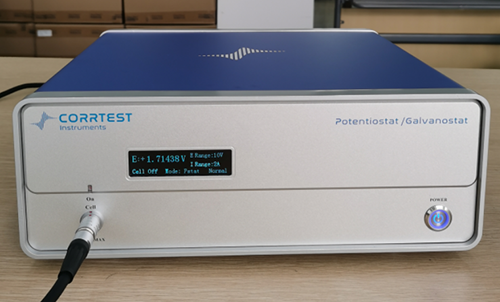
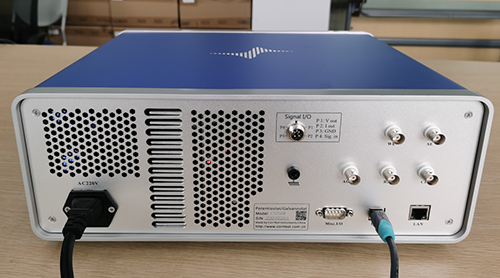
● Study of Energy materials (Li-ion battery, solar cell, fuel cell, supercapacitors), advanced functional materials
● Electrocatalysis (HER, OER, ORR, CO2RR, NRR)
● Corrosion study and corrosion resistance evaluation of metals; quick evaluation of corrosion inhibitors, coatings, and cathodic protection efficiency
● Electrosynthesis, electroplating/electrodeposition, anode oxidation, electrolysis
Specifications
Support 2-, 3- or 4-electrode system
Potential control range: ±10V
Current control range: ±2A
Potential control accuracy: 0.1%×full range±1mV
Current control accuracy: 0.1%×full range
Potential resolution: 10μV(>100Hz), 3μV (<10Hz)
Current sensitivity: 1pA
Potentiostat rise time: <1μs (<10mA), <10μs(<2A)
Reference electrode input impedance: 1012Ω||20pF
Current range: 2nA~2A,10 ranges
Compliance voltage: ±21V
Maximum current output: ±2A
CV and LSV scan rate: 0.001mV~10,000V/s
CA and CC pulse width: 0.0001~65,000s
Current increment during scan: 1mA@1A/ms
Potential increment during scan: 0.076mV@1V/ms
SWV frequency: 0.001~100 kHz
DPV and NPV pulse width: 0.0001~1000s
AD data acquisition: 16bit@1 MHz,20bit@1 kHz
DA Resolution: 16bit, setup time: 1μs
Minimum potential increment in CV: 0.075mV
IMP frequency: 10μHz~1MHz
Low-pass filters: covering 8-decade
Potential and current range: automatic
EIS specifications
Signal generator:
Frequency range: 10μHz~1MHz
Frequency accuracy: 0.005%
AC signal amplitude: 1mV~2500mV
Signal resolution: 0.1 mV RMS
DC Bias: -10~+10V
Output impedance: 50Ω
Waveform: Sine wave, triangular wave and square wave
Wave distortion: <1%
Scan mode: Logarithmic/linear, increase/decrease
Signal analyzer:
Integral time: minimum: 10ms or the longest time of a cycle
Maximum: 106 cycles or 105s
Measurement delay: 0~105s
DC offset:
Potential automatic compensation range: -10V~+10V
Current compensation range: -1A~+1A
Bandwidth: 8-decade frequency range, automatic and manual setting
OS Requirements
Operating System: Windows 10/11
Communication between PC and potentiostat: USB
Dimensions(cm):36 ×30×14; net weight: 6.5kg; After packing: 10kg, 53*38*25cm
Techniques -CS350M
Stable polarization
- Open Circuit Potential (OCP)
- Potentiostatic (I-T curve)
- Galvanostatic
- Potentiodynamic (Tafel plot)
- Galvanodynamic (DGP)
- Multi Potential Steps
- Multi Current Steps
- Potential Stair-Step (VSTEP)
- Galvanic Stair-Step (ISTEP)
- Chronopotentiometry (CP)
- Chronoamperametry (CA)
- Chronocaulometry (CC)
- Linear Sweep Voltammetry (LSV)
- Cylic Voltammetry (CV)
- Staircase Voltammetry (SCV) #
- Square Wave Voltammetry (SWV) #
- Differential Pulse Voltammetry (DPV) #
- Normal Pulse Voltammetry (NPV) #
- Differential Normal Pulse Voltammetry (DNPV) #
- AC Voltammetry (ACV)
- 2nd harmonic AC Voltammetry (SHACV)
- Fourier Transform AC Voltammetry (FTACV)
Electrochemical Impedance Spectroscopy (EIS)
- Potentiostatic EIS (Nyquist, Bode)
- Galvanostatic EIS
- Potentiostatic EIS (Optional freq.)
- Galvanostatic EIS(Optional freq.)
- Mott-Schottky
- Potentiostatic EIS vs. Time (Single freq.)
- Galvanostatic EIS vs. Time (Single freq.)
- Cyclic polarization curve (CPP)
- Linear polarization curve (LPR)
- Electrochemical Potentiokinetic Reactivation (EPR)
- Electrochemical Noise (EN)
- Zero resistance Ammeter (ZRA)
- Battery Charge and Discharge
- Galvanostatic Charge and Discharge (GCD)
- Potentiostatic Charging and Discharging(PCD)
- Potentiostatic Intermittent Titration Technique (PITT)
- Galvanostatic Intermittent Titration Technique (GITT)
- Differential Pulse Amperometry (DPA)
- Double Differential Pulse Amperometry (DDPA)
- Triple Pulse Amperometry (TPA)
- Integrated Pulse Amperometric Detection (IPAD)
- Electrochemical Stripping/ Deposition
- Bulk Eletrolysis with Coulometry (BE)
- Rs Measurement
Corrosion
Corrtest potentiostat includes all the electrochemical techniques for corrosion measurement such as OCP, polarization curve (potentiodynamic), EIS, Cyclic polarization CPP (passivation curve), Electrochemical Potentiokinetic Reactivation (EPR), Hydrogen diffusion test, ZRA, Electrochemical noise, etc. It can be used to study metal corrosion mechanism and corrosion resistance, and evaluate the coating durability and sacrificial anode current efficiency. It can also be used for rapid screening of corrosion inhibitors, fungicides, etc.

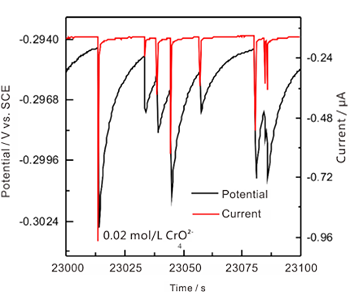
Left: Polarization curve of Ti-based amorphous alloy & stainless steel in 3%NaCl solution
Right: ECN of low-carbon steel in 0.05mol/LCl+0.1mol/LNaHCO3
Right: ECN of low-carbon steel in 0.05mol/LCl+0.1mol/LNaHCO3
It uses correlation integral algorithm and dual-channel over- sampling technique, and has strong anti-interference ability. The internal resistance of the instrument is up to 1013Ω. It's suitable for EIS measurements of high-impedance system (such as coating, concrete etc)
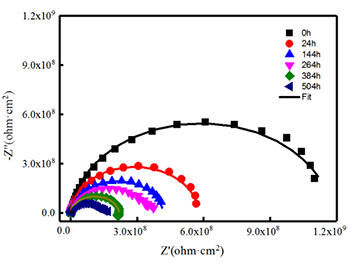
Salt spray aging test of high impedance coating
With techniques LSV, CV, galvanostatic charge and discharge (GCD), Constant potential/ current EIS, and precise IR compensation circuit, Corrtest potentiostats are widely used in supercapacitor, Li-ion batteries, sodium-ion batteries, fuel cell, Li-S batteries, solar cell, solid-state batteries, flow batteries, metal-air batteries etc. It is an excellent scientific tool for researchers in the fields of energy and materials.
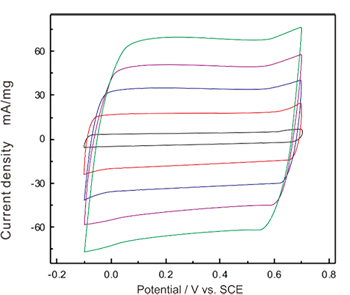
CV curve of PPy supercapacitor in 0.5 mol/L H2SO4 solution
Electrocatalysis
● Corrtest potentiostat can measure the half-wave potential (ORR), overpotential (HER, OER) of the catalyst, and has the function of peak power density and energy density calculation.
● Long-term cyclic measurement for ORR, OER, HER,CO2RR by techniques such as cyclic voltammetry, potentiostatic, galvanostatic. Faraday efficiency can be measured with a bipotentiostat.
● Maximum current can be 20A/40A and compliance voltage can be 30V, and with IR compensation technique,Corrtest potentiostat can precisely measure the overpotential of the electrode, which is a big advantage in electrocatalysis field.
● Corrtest potentiostat can measure the half-wave potential (ORR), overpotential (HER, OER) of the catalyst, and has the function of peak power density and energy density calculation.
● Long-term cyclic measurement for ORR, OER, HER,CO2RR by techniques such as cyclic voltammetry, potentiostatic, galvanostatic. Faraday efficiency can be measured with a bipotentiostat.
● Maximum current can be 20A/40A and compliance voltage can be 30V, and with IR compensation technique,Corrtest potentiostat can precisely measure the overpotential of the electrode, which is a big advantage in electrocatalysis field.
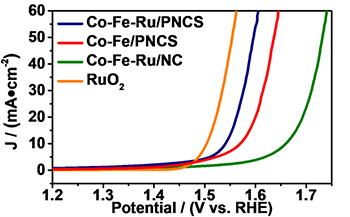
LSV curve of catalysts in alkaline solution
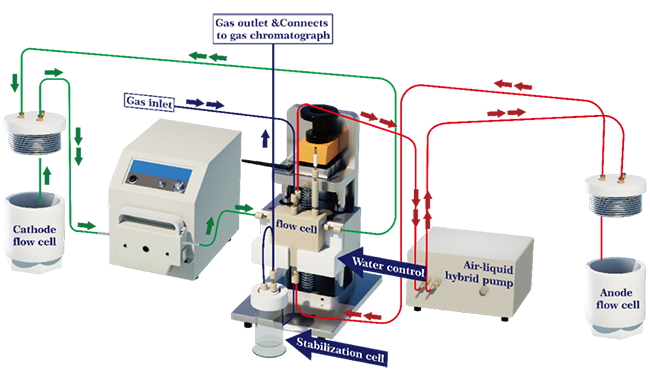
CS350M potentiostat includes all the voltammetric methods such as NPV, DNPV, SWV, ACV, and can be used for fast analysis of the trace elements in the solution. Voltammetry stripping methods can do the Quantitative analysis according to the stripping peak current.
.png)
Stripping voltametric curves in solution of different Pb2+, Cd 2+,Zn2+ concentration
Advantages
Full floatingAll Corrtest potentiostats / galvanostats are designed as full-floating, and can be used for electrochemical study of working electrode connecting to earth, such as autoclave, metal part in bridge, concrete
Real-time data storage
Experiment data can be stored in real time. Even if the test is interrupted by a power failure, the data will be automatically saved. The data is compatible with Excel, Origin, and can be directly opened.
EIS
● Corrtest potentiostat uses correlation integral algorithm and dual-channel over-sampling technique, and has strong anti-interference ability. The internal resistance of the instrument is up to 1013Ω. It's suitable for EIS measurements of high-impedance system (such as coating, concrete etc.)
● With constant current carrier and DC bias technology, Corrtest potentiostat can be used for battery impedance measurement under charge and discharge state, suitable for ultra-low resistance system (such as 18650 battery, soft pack battery, battery core...)
Multi electrode system
● Support 2-, 3-, 4-electrode system, can be used to test battery internal resistance or 4-electrode thin film impedance measurement
● With Zero resistance ammeter for galvanic current measurement
Software development kit(SDK)
We can provide secondary development interfaces,API general interfaces and development examples, and can realize data call for Labview, C, C++, C#, VC and other program, which is convenient for secondary development and test methods customization.
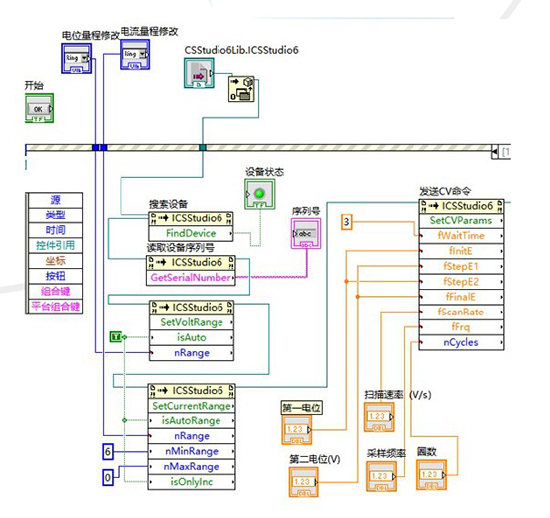
High current, high compliance options
●With the CS2020B/CS2040B booster, the current can be boosted to 20A/40A, which meets the requirement in fuel cell, power battery, electroplating, etc
●Can customize the instrument to be 30V high compliance voltage, which meets the test requirement in low-conductivity solutions (organic system, concrete system etc), especially suitable for carbon and nitrogen reduction study.
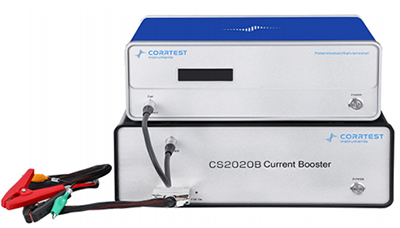
CS Studio is the software for Corrtest potentiostat for experiment control and data analysis. It can do: multi-parameter Tafel curve fitting, derivation, integration and peak height analysis of voltammetric curve, EIS equivalent circuit customization and impedance spectrum fitting, etc.
● Multi-parameters Polarization curve
● EIS fitting
● Electrochemical noise analysis
● Pseudo capacitance calculation
● GCD specific capacitance, efficiency
● Mott-Schottky plot analysis
● CV analysis
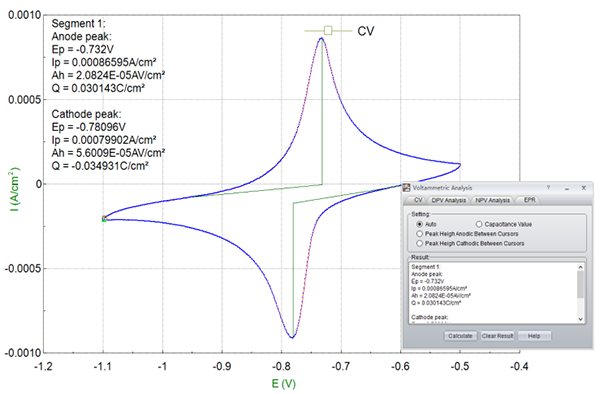
CS studio software supports the combination test for various experiments to achieve flexible and
unattended test. You can set the parameters for each experiment in advance, and set the intervals, wait time etc between each experiment.
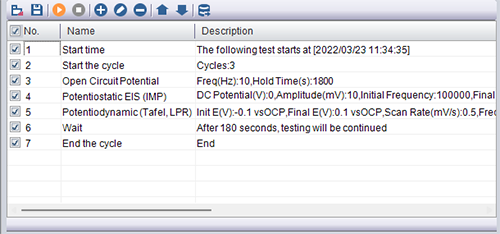
Combination Test: corrosion tests

Combination Test: Pseudocapacitor tests
Software Features
Cyclic voltammetry: CS studio software provides users a versatile smoothing/differential/ integration kit, which can complete the calculation of peak height, peak area and peak potential of CV curves. In CV technique, during the data analysis, there is function of selecting exact cycle(s) to show. You can choose to see a cycle or some cycles as you want. You can also export data or vector graph of an exact cycle or several cycles.
Tafel plot and corrosion rate:
CS studio also provides powerful non-linear fitting on Butler-Volmer equation of polarization curve. It can calculate Tafel slope, corrosion current density, limitation current, polarization resistance, corrosion rate. It can also calculate the power spectrum density, noise resistance and noise spectrum resistance based on the electrochemical noise measurements.
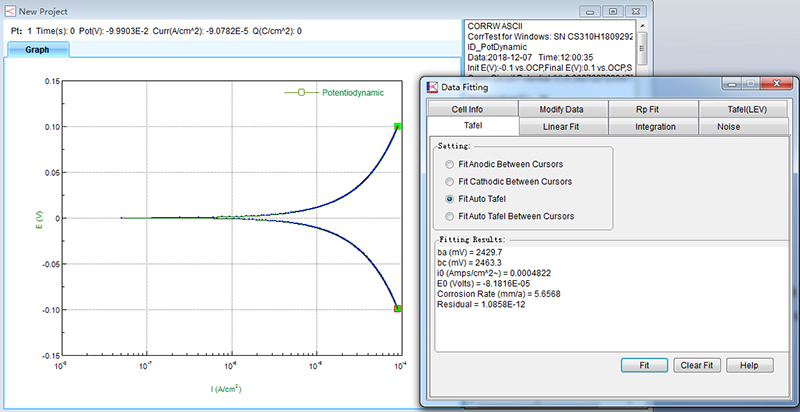
Battery Test and analysis: charge & discharge efficiency, capacity, specific capacitance, charge & discharge energy.
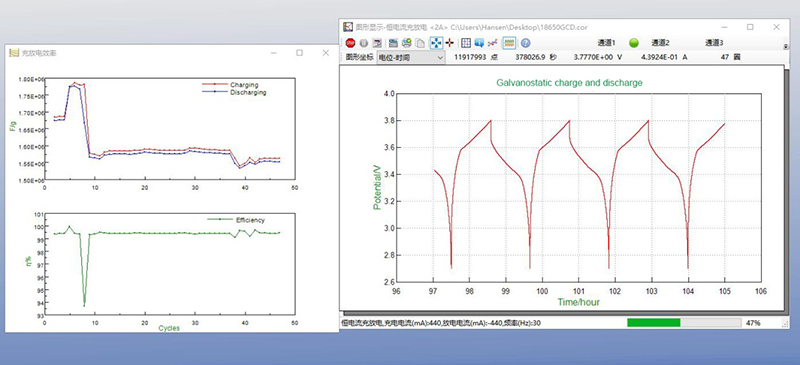
EIS analysis: Bode, Nyquist, Mott-Schottky plot
During EIS data analysis, there is built-in fitting function to draw the custom equivalent circuit.
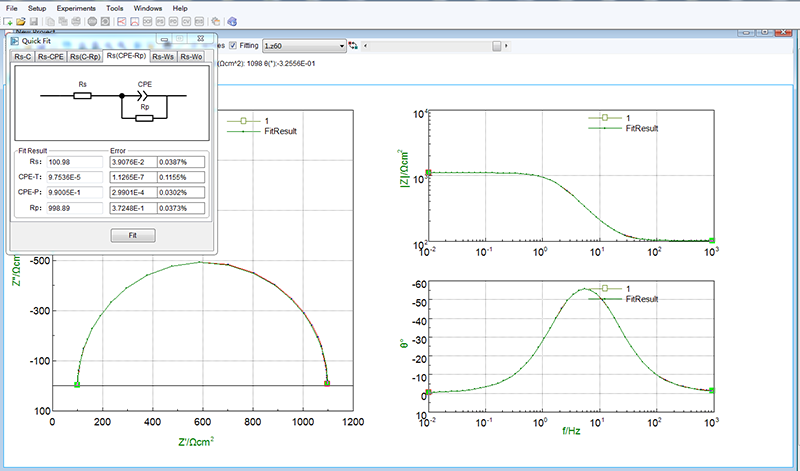
Standard supply-CS350M
Instrument host CS350M
CS studio software
Power cable x1
USB cable x1
Cell/electrode cable x2
Dummy cell(1kΩ||100µF) x1
Manual
Techniques- models comparison
| Techniques | CS300M NO EIS |
CS310M WITH EIS |
CS350M WITH EIS |
|
| Stable polarization |
Open Circuit Potential (OCP) | √ | √ | √ |
| Potentiostatic (i-t curve) | √ | √ | √ | |
| Galvanostatic | √ | √ | √ | |
| Potentiodynamic(Tafel plot) | √ | √ | √ | |
| Galvanodynamic | √ | √ | √ | |
| Transient polarization | Multi-Potential Steps | √ | √ | √ |
| Multi-Current Steps | √ | √ | √ | |
| Potential Stair-Step (VSTEP) | √ | √ | √ | |
| Galvanic Stair-Step (ISTEP) | √ | √ | √ | |
| Chrono methods |
Chronopotentiometry (CP) | √ | √ | √ |
| Chronoamperometry (CA) | √ | √ | √ | |
| Chronocoulometry (CC) | √ | √ | √ | |
| Voltammetry | Cyclic Voltammetry (CV) | √ | √ | √ |
| Linear Sweep Voltammetry (LSV)(i-v) | √ | √ | √ | |
| Staircase Voltammetry (SCV) # | √ | √ | ||
| Square wave voltammetry (SWV) # | √ | √ | ||
| Differential Pulse Voltammetry (DPV)# | √ | √ | ||
| Normal Pulse Voltammetry (NPV)# | √ | √ | ||
| Differential Normal Pulse Voltammetry (DNPV)# | √ | √ | ||
| AC voltammetry (ACV) # | √ | √ | ||
| EIS | Potentiostatic EIS (Nyquist, Bode) | √ | √ | |
| Galvanostatic EIS | √ | √ | ||
| Potentiostatic EIS (Optional freq.) | √ | √ | ||
| Galvanostatic EIS(Optional freq.) | √ | √ | ||
| Mott-Schottky | √ | √ | ||
| Potentiostatic EIS vs. Time (Single freq.) | √ | √ | ||
| Galvanostatic EIS vs. Time (Single freq.) | √ | √ | ||
| Corrosion measurement |
Cyclic polarization curve (CPP) | √ | √ | √ |
| Linear polarization curve (LPR) | √ | √ | √ | |
| Electrochemical Potentiokinetic Reactivation (EPR) | √ | √ | √ | |
| Electrochemical Noise (EN) | √ | √ | √ | |
| Zero resistance Ammeter (ZRA) | √ | √ | √ | |
| Battery test | Battery charge and discharge | √ | √ | √ |
| Galvanostatic charge and discharge (GCD) | √ | √ | √ | |
| Potentiostatic Charging and Discharging(PCD) | √ | √ | √ | |
| Potentiostatic Intermittent Titration Technique(PITT) | √ | √ | √ | |
| Galvanostatic Intermittent Titration Technique(GITT) | √ | √ | √ | |
| Amperometry | Differential Pulse Amperometry (DPA) | √ | ||
| Double Differential Pulse Amperometry (DDPA) | √ | |||
| Triple Pulse Amperometry (TPA) | √ | |||
| Integrated Pulse Amperometric Detection (IPAD) | √ | |||







 Contact Us
Contact Us +86 13469965984
+86 13469965984